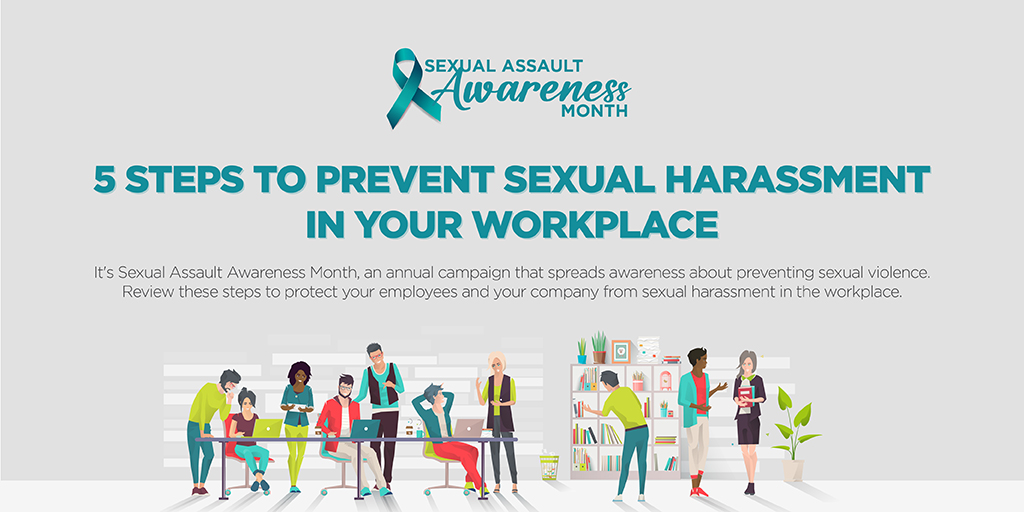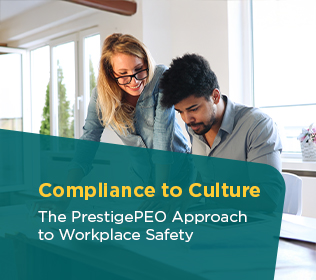
April is Sexual Assault Awareness Month, an annual campaign focused on education and spreading awareness about how to prevent sexual violence. Sexual harassment can happen anywhere and at any time, but as a business owner you must take the correct steps to prevent harassment in your workplace and take complaints seriously. In this blog post, we will review the steps you should take to protect your employees and your company from sexual harassment in the workplace. Take a moment to review this information and if you need any assistance implementing these processes, contact us for additional support.
1. Provide sexual harassment training
If you’re in one of these states:
- California
- Connecticut
- Delaware
- Illinois
- Maine
- Massachusetts
- New York
You’ve likely already implemented a sexual harassment training policy into your onboarding process. These states all require mandatory sexual harassment training, but each state has its stipulations on how often this training must be completed, how long it should be, and other regulations (check out this list to see what your state requires). Some states, like New York, require annual sexual harassment training, others biannually. If your state doesn’t require this training, it’s recommended to include it anyway. By having mandatory sexual harassment training for all employees, you’ll take the first step in providing a safe workspace.
Harassment can occur anywhere, including virtually. If your company is based in a state that requires sexual harassment training, be sure to notify and train employees in out-of-state offices as well as those working remotely. As individuals involved in a sexual harassment situation do not necessarily need to be in the same room for harassment to occur, it’s important to review this training with all employees regardless of where they physically sit for work.
Additionally, if you have employees who sit in different states that have different sexual harassment training requirements, then it’s imperative to make sure all employees are trained. For example, if your company is based in Virginia, and you have an employee that works remotely from California, you’ll need to make sure they receive sexual harassment training aligned with the requirements in California. Additionally, if your employee in Virginia is interacting with an employee in California, your Virginia employee should receive sexual harassment training even though their state doesn’t require it. This can be confusing for employers, but fortunately, as a client of PrestigePEO, we will work with you through these details.
2. Have an anti-harassment policy
Having your employees complete their sexual harassment training is essential, but you should also draft an anti-harassment policy and have your employees sign off on it. This way, you have a record that every employee has acknowledged this policy if something ever happens in the future. It helps to make sure that everyone is on the same page and that they are aware that your company has a no-tolerance policy regarding harassment. You can check out an example of an anti-harassment policy here.
3. Make sure your employees know where to report harassment
You probably included the reporting process within your sexual harassment training, but it may be sometime later that an employee needs to use it. We recommend that you have a place your employees can access the details of the reporting process, perhaps on your company’s server or on an employee self-service portal. Your employees may be afraid to approach someone to ask where to find it, so having it in a neutral location will allow them to access it privately. Additionally, have more than one option for reporting harassment. For example, an employee might ideally report it to their direct supervisor. Still, there is always the possibility that the supervisor is the source of the harassment, and therefore reporting to the supervisor would be inappropriate.
4. Managers and supervisors need additional sexual harassment training
When you’re in a supervisory position, you are held to a higher standard than the average employee. If you are a supervisor and witness harassment, you could be held liable if you don’t report it. Even though you didn’t participate in the harassment, you must report it if you see it, hear it, or if someone tells you about it. Therefore, your managers and supervisors must be aware of this and should receive extra training to understand their responsibilities. They also need to be hyper-aware of what harassment looks or sounds like, so they are mindful of it occurring in the workplace.
5. Take every complaint seriously
If your company receives a sexual harassment complaint, it is crucial that you take it seriously. You could put your company at risk for litigation if you do not properly investigate and address every claim you receive. As soon as you receive a complaint, contact your HRBP, who will walk you through the process. Even if the claim seems frivolous to you, it could have been devastating to the person who endured it. Every harassment complaint must be investigated thoroughly.
The above steps will help create a respectful and safe work environment for your entire organization. The only way to prevent sexual harassment is to ensure that everyone is doing their part. That’s why it is vital to prioritize sexual harassment training and awareness every year. If you have any questions about how to incorporate a sexual harassment policy into your workplace, we are happy to help. Whether you are a current PrestigePEO client that has yet to take advantage of this helpful guidance or are brand new to a PEO, you can see how supportive our services can be. We don’t just offer employee benefits; instead, we provide a full-service HR management team that is trained in giving your business the support it needs. If you are interested in learning how PrestigePEO can help, contact us directly at info@prestigepeo.com.




